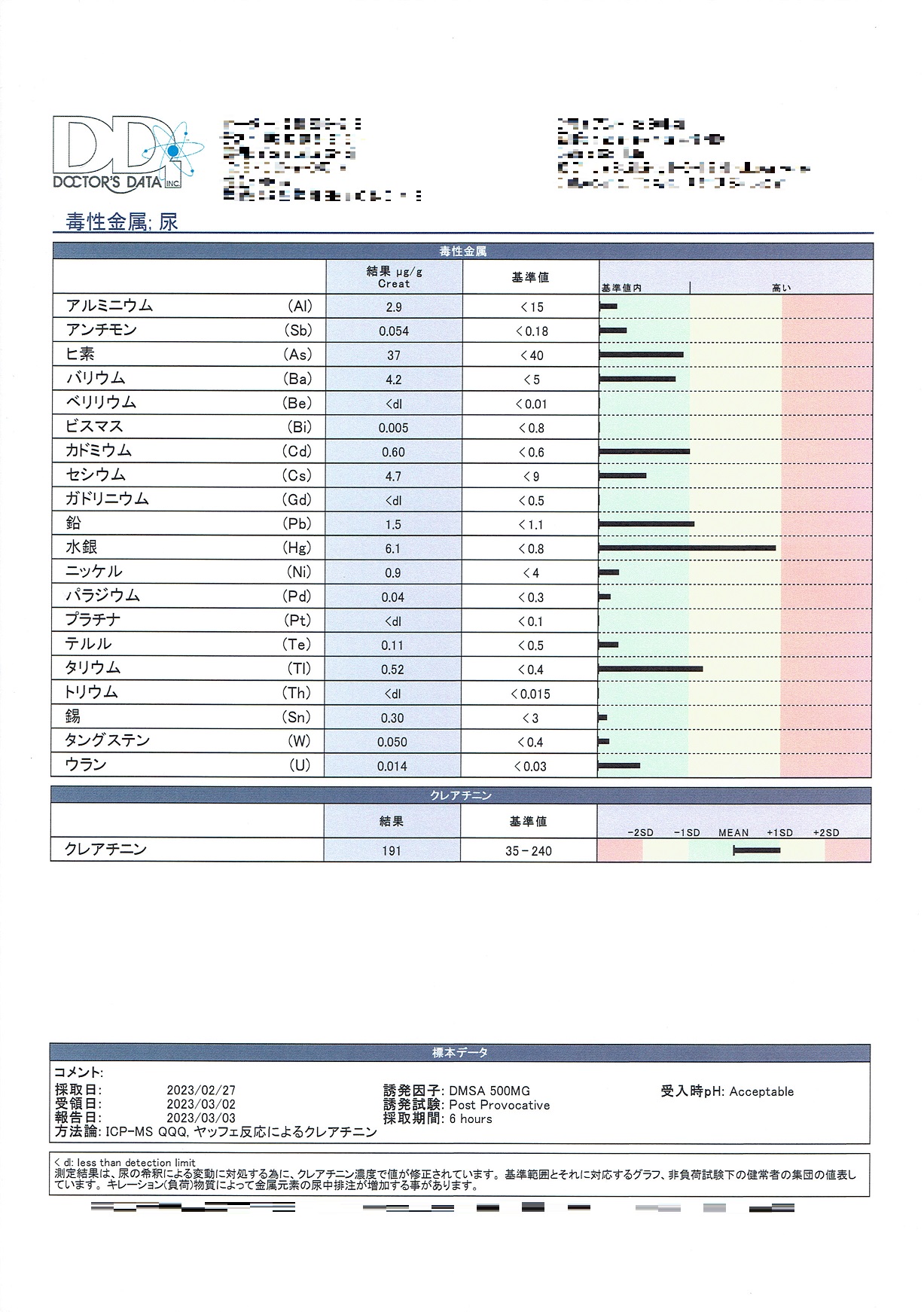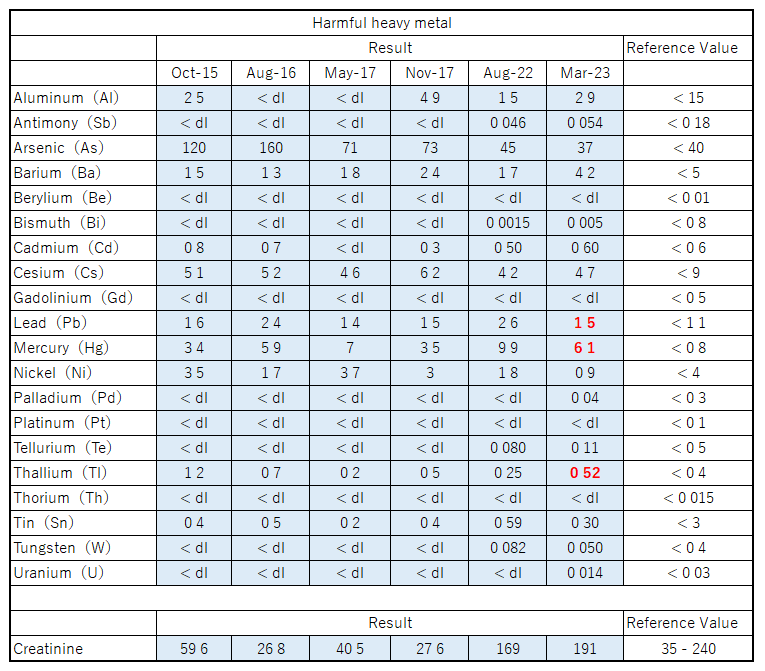
table of contents
Urinary excretion heavy metal test
Urinary excretion heavy metal test results in March 2023

Urinary excretion heavy metal test
Harmful heavy metal
Result, Reference Value, Within Reference Value, High
Aluminum (Al) 2 9
Antimony (Sb) 0 054
Arsenic (As) 37
Barium (Ba) 4 2
Beryllium (Be) <dl
Bismuth (Bi) 0 005
Cadmium (Cd) 0 60
Cesium (Cs) 4 7
Gadolinium (Gd) <dl
Lead (Pb) 1 5
Mercury (Hg) 6 1
Nickel (Ni) 0 9
Palladium (Pd) 0 04
Platinum (Pt) <dl
Tellurium (Te) 0 11
Thallium (Tl) 0 52
Thorium (Th) <dl
Tin (Sn) 0 30
Tungsten (W) 0 050
Uranium (U) 0 014
Creatinine
Creatinine 191
Specimen data
Measurement results are corrected for creatinine concentration to account for variations due to urine dilution.
Reference ranges and corresponding graphs represent values for a healthy population under unloaded testing.
Chelating (loading) substances may increase urinary excretion of metallic elements.
Comparison of test results
Comparative data is from October 2015, August 2016, May 2017, November 2017, August 2022 and March 2023.
From left: October 2015 data, August 2016 data, May 2017 data, November 2017 data, August 2022 data, March 2023 data.
Urinary excretion Compare 20 heavy metal test items.
Display numerical values and graphs separately.

Aluminum (Al) 2 5 → <dl → <dl → 4 9 → 1 5 → 2 9 Go up
Antimony (Sb) <dl → <dl → <dl → <dl → 0 046 → 0 054 Go up
Arsenic (As) 120 → 160 → 71 → 73 → 45 → 37 Go down
Barium (Ba) 1 5 → 1 3 → 1 8 → 2 4 → 1 7 → 4 2 Go up
Beryllium (Be) <dl → <dl → <dl → <dl → <dl → <dl No detection
Bismuth (Bi) <dl → <dl → <dl → <dl → 0 015 → 0 005 Go down
Cadmium (Cd) 0 8 → 0 7 → <dl → 0 3 → 0 50 → 0 60 Go up
Cesium (Cs) 5 1 → 5 2 → <dl → 6 2 → 4 2 → 4 7 Go up
Gadolinium (Gd) <dl → <dl → <dl → <dl → <dl → <dl No detection
Lead (Pb) 1 6 → 2 4 → 1 4 → 1 5 → 2 4 → 1 5 Go down
Mercury (Hg) 3 4 → 5 9 → 7 → 3 5 → 9 9 → 6 1 → Go down
Nickel (Ni) 3 5 → 1 7 → 3 7 → 3 → 1 8 → 0 9 Go down
Palladium (Pd) <dl → <dl → <dl → <dl → <dl → 0 04 Go up
Platinum (Pt) <dl → <dl → <dl → <dl → <dl → <dl No detection
Tellurium (Te) <dl → <dl → <dl → <dl → 0 080 → 0 11 Go up
Thallium (Tl) 1 2 → 0 7 → 0 2 → 0 5 → 0 25 → 0 52 Go up
Thorium (Th) <dl → <dl → <dl → <dl → <dl → <dl No detection
Tin (Sn) 0 4 → 0 5 → 0 2 → 0 4 → 0 59 → 0 30 Go down
Tungsten (W) <dl → <dl → <dl → <dl → 0 082 → 0 050 Go down
Uranium (U) <dl → <dl → <dl → <dl → <dl → 0 014 Go up
Values for aluminum, antimony, barium, cadmium, cesium, palladium, tellurium, and uranium have increased since the previous survey, but are still within the standard range.
Lead, mercury, and thallium exceed the standard values.
The figures for lead and mercury have fallen since the last time.
As for thallium, the number has increased since the last time.

Aluminum is within the standard value, so there is no problem.
Antimony is within the standard value, so there is no problem.
Arsenic is within the standard value, so there is no problem.
Barium is within the standard value, so there is no problem.
Beryllium not detected.
Bismuth is within the standard value, so there is no problem.
Cadmium is within the standard value, so there is no problem.
Cesium is within the standard value, so there is no problem.
Gadolinium not detected.
The value of lead is 1 5μg/g, exceeding the upper limit of 1 1μg/g.
The value of mercury is 6 1μg/g, which greatly exceeds the upper limit of the standard value of 0 8μg/g.
Nickel is within the standard value, so there is no problem.
Palladium is within the standard value, so there is no problem.
Platinum not detected.
Tellurium is within the standard value, so there is no problem.
The value of thallium was 0 52 μg/g, slightly exceeding the upper limit of 0 4 μg/g.
Thorium not detected.
Tin is within the standard value, so there is no problem.
Tungsten is within the standard value, so there is no problem.
Uranium is within the standard value, so there is no problem.
The results of the sixth test showed that heavy metals other than lead, mercury and thallium were within the standard range.
Although lead and thallium exceed the standard values, they are not high.
Mercury far exceeded the standard value, and it was found that it was still accumulating in the body.
It is thought that the mercury in the cells was discharged due to the effect of the tathion tablets that he was taking.
Taking Tathion tablets has a certain effect of discharging intracellular mercury.
Elimination of mercury can take time, depending on how much is stored in the body.